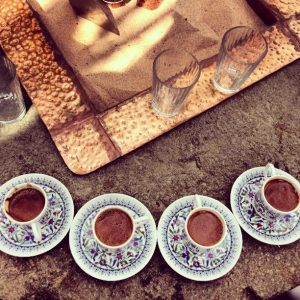Reading Unit 2 Podcast Lecture Blog I was intrigued by the phrases Amanda Smith said “participating in something that has not changed”, “It has maintained itself” trying to describe authenticity. I came to think about tulips in Amsterdam Airport. Usually, in airports, there are souvenirs that best represent that country’s authenticity. All stores in the airport had tulips or tulips seeds to bring back home to plant and grow something representative of the Netherlands. However, the most representative of the Netherlands, tulips were actually brought from the Ottoman Empire, today’s Turkey. The Turkic groups brought tulips from Central Asia, the Pamir Mountains to Anatolia while migrating for decoration purposes eventually being brought to the Netherlands as a representative symbol.
On the other hand, the Turkish coffee that is sold in the markets is labeled mostly as proudly authentic Turkish coffee. However, Turkish coffee was also brought into Turkey from Yemen and Sultan Suleyman who loved it popularized this type of coffee in Istanbul.
Today, the term “authenticity” only remains as a marketing term as mentioned in Unit 2 Podcast Lecture Blog (Amanda Smith) in order to attract tourists who obsess about the concepts of untouched and pure. If we remember the Introduction reading from Tuhiwai Smith, Tuck & Yang, the term “purity” was defined as “destructive” and “isolating” around many concepts including cultural and ceremonial knowledge (3). Authenticity is associated with being pure and not changed since the beginning. However, aspiring the pure and authentic is isolating all the history and power hierarchies behind that culture. Essentially, assuming that an ayahuasca experience is authentic is to ignore the sufferings of the Indigenous people during the rubber boom as Amanda Smith explains. It is impossible to see things as untouched because through globalization everything is accessible and all cultural practices are diffusing. Each culture has been appropriating various aspects of cultural forms into their traditions inevitably with the impact of globalization.
This inevitably mixing cultures remind of me the happenings that I learned in my Arts History class during my exchange in Mexico. The participation and the audience involvement in happenings take place in the creating of art defying the traditional barriers between the artist, the work, and the viewers. This is one of the ways to see the diffusion of cultures and constantly creating something new. In the Unit 2 Podcast Lecture Blog, Tamara explains how some tourists would be criticized for not purchasing authentic textiles because they would have elements of Western aesthetics. In this case, I see the artist as the Indigenous women, the art as the textile, and the viewer as the tourist. When the artist/Indigenous women and the viewer/tourists interact the final product is naturally influenced by both creating something new by mixing two elements just like in happenings.
Therefore we should be aware of the harm when we idolize a concept that does not even exist which is authenticity. Rather we should encourage ourselves to learn and love the interconnectedness of many cultures and histories within one culture. It is way more fun to put the pieces of the puzzle together and enjoy each piece.


Fantastic connection between the “pure” experience sought by tourists of ayahuasca shamanism and the critique of “purity” discourse in Tuhiwai Smith, Tuck, and Yang. Your reading of why seeking “authenticity” is problematic and ultimately unnecessary is astute. Thanks, Alara!